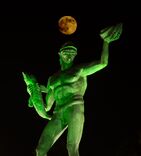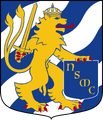Eliseborg (Luthorianized: Eliseburg; abbreviated Ebg) is the third-largest city in Davostag, and largest city of the Province of Bindeborg. It is situated by the Unholy Sea, on the eastern coast of Bindeborg Proper, and has a population of approximately 570,000 in the city proper and about 1 million inhabitants in the metropolitan area.
Eliseborg was founded as Sydborg, a heavily fortified, trading colony, in 1032 by Kivonian general Gustav Feldt. In addition to the generous privileges – such as tax relaxation – given to his trading allies across the Unholy Sea, the general also attracted significant numbers of Kivonians and Skjölds to populate the only town on the south-eastern coast. At a key strategic location at the mouth of the Elise älv, where Bindeborg's largest drainage basin enters the sea, the Port of Eliseborg is now the largest port in western Macon.
Eliseborg is home to many students, as the city includes the National College of Eliseborg and the smaller University of Eliseborg. The city is served by Eliseborg City Airport 15 km (9.3 mi) southeast of the city center. It also hosts the Elisa Cup, and the Eliseborg Commercial Festival. The city also serves as the headquarters of the Confederate Economic Security Union.
Name[]
The city was named Sydborg by Kivonian general Gustav Feldt. The Kivonian name was given after its geographic location in terms of where the Kivonian people were originally populated, and simultaneously given the Luthorian name Southernburg.
However with the later Davostani supremacy and with Luthorian merchants receiving influence over the city, it was named St. Leonard, however no current historical documents exists of an individual or saint named "Leonard". It was the city's longest held name. In 4688 during the Democratic Restoration Age, the city was named Møllested, in order to bring a more localized version, however, this was seen as an insult against the Kivonian inhabitants, since the name were in Skrigere.
During the later years of the Third Kivonian Republic, in 4776, the city was finally named Eliseborg, after the great Kivonian hero, Elise Reinhardt, who had seized control of the New Kivonian Republic in the 4640s. It was renamed not only to honor her, but also to insult the House of Ashé-Rivières, which had ruled the New Republic before before being ousted by Reinhardt, and which at the time of the name change ruled Telamon and had declared war on the Third Republic in order to reclaim their previous rulership.
Government[]
Eliseborg is a city municipality with a city council consisting of 50 members, elected every six year. Political decisions depend on citizens considering them legitimate. Political legitimacy can be based on various factors: legality, due process, and equality before the law, as well as the efficiency and effectiveness of public policy. One method used to achieve greater legitimacy for controversial policy reforms such as congestion charges is to allow citizens to decide or advise on the issue in public referendums.

View over Gustav Feldts torg, square named after Gustavus Feldtus, the founding father of Eliseborg
Culture[]

Poseidon Statue at Eliseplatsen, a well-known cultural symbol and landmark
Eliseborg is considered one of the most important symbols of Kivonian culture, as it being a city founded for military purposes, and which is considered the bastion of Kivonian expansion southwards.
Museums[]
Many of the cultural institutions, as well as hospitals and the university, were created by donations from rich merchants and industrialists, for example the Rövarson Museum. Museums include the Eliseborg Museum of Art, and several museums of sea and navigation history, natural history, the sciences, and Northeast-Artania.
Folkståndets Kunskapscenter ("Knowledge Center of the Population"), also known as Fokuscentret, is a project currently being designed as a public science centre believed to be opening in year 4899, its size is said to make it the largest of its kind in western Macon. It is divided into six sections, each containing experimental workshops and a collection of reptiles, fish, and insects. Fokuscentret also hopes to occasionally host debates between local secondary-school students and nation award wining scholars.
Economics[]
Due to Eliseborg's advantageous location in the centre of the Unholy Sea, trade and shipping have always played a major role in the city's economic history, and they continue to do so. Eliseborg port has come to be the largest harbour in western Macon.
Apart from trade, the second pillar of Eliseborg has traditionally been manufacturing and industry, which significantly contributes to the city's wealth. Major companies operating plants in the area include Shippington, and Fortuna Group. Tofors AB is one of the largest employer in Eliseborg, not including jobs in supply companies. The blue-collar industries which have dominated the city for long are still important factors in the city's economy, but they are being gradually replaced by high-tech industries.
Symbols[]

The coat of arms of the city
The official coat of arms of the city of Eliseborg, is a shield with waving white and blue stripes representing the ocean and its importance as a port-city. Upon the stripes stands a golden lion with a crown and sword, representing Gustavus Feldtus – who was known as Sydhärernas Lejon ("the Lion of the Southern Armies"). The sword represents the city's founding as a military fortress. The lion holds with one of its paws on another shield, with a blue background and the letters "NSMC" in gold. The abbreviated phrase referring to the national and cultural motto of the Kivonians, Nation, Stolthet, Militär, Centralitet ("Nation, Pride, Military, Centrality").


